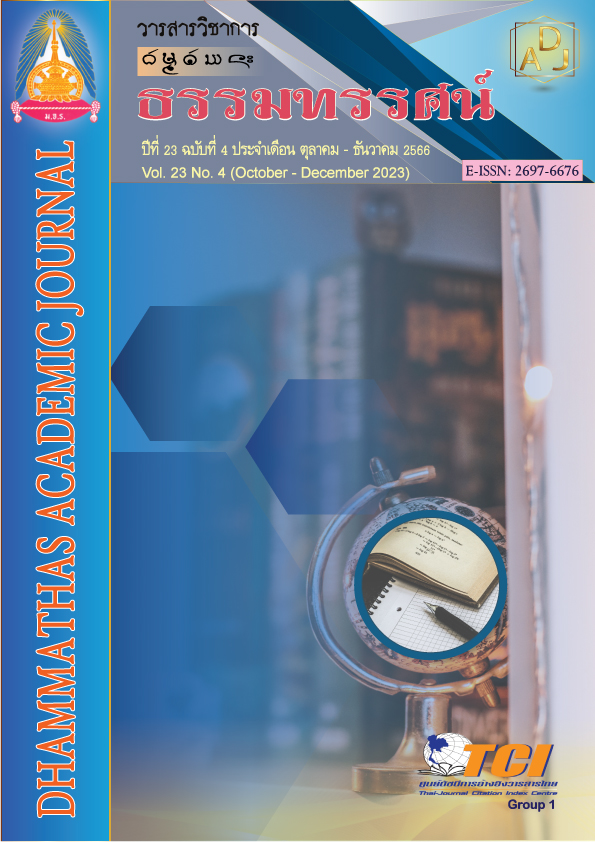Development of Local Wisdom for Agricultural Water Conservation and Allocation in Nonirrigated Area of Sanpatong District, Chiang Mai Province
Main Article Content
Abstract
This qualitative research aimed to examine the implementation of local knowledge for agricultural water conservation and allocation, apply the wisdom to new technology, and create agricultural water conservation and allocation innovation based on the King’s Philosophy in non-irrigated areas. The population size is 21,044 people. A purposive sampling method is employed to select a sample group of 30 individuals for this qualitative research study.
The results revealed that:
1. Agricultural water allocation in the weir system began in 638 with the creation of Ngern Yang Township (Chiang Rai province). The superstructure controlled the system, including politics, law, customs, and culture. The lower structure consists of labor, technology, and natural materials. Human and animal labor works were used during construction. Moreover, land belonged to the ruling class. Commoners had to be permitted to own land, and labor and tributes were required to pay land rent fees. However, this situation was changed in 1899. The use of local wisdom in building weirs began to change when the Department of Irrigation initiated concrete weirs' construction since 1977. However, the organization and management of weir systems were entrusted to a committee elected by local residents. This committee became responsible for overseeing weir systems. The government is in charge of the construction and repair of weirs.
2. Currently, there is a problem of water scarcity, and addressing this issue through water conservation and allocation requires a comprehensive solution. These strategies involve legal regulations controlling agricultural land use, transitioning production systems by cultivating water-efficient crops, applying new agricultural theories, and utilizing appropriate technologies. Practices such as afforestation, dam construction, reservoirs, and weir establishment could also resolve water-related challenges. Introducing the principles of a sustainable economy helps mitigate cultural disparities, ensuring a complete and effective solution. Success is achieved when political, economic, technological, environmental, and cultural aspects align and work harmoniously to solve the problem.
Article Details

This work is licensed under a Creative Commons Attribution-NonCommercial-NoDerivatives 4.0 International License.
เพื่อให้เป็นไปตามกฎหมายลิขสิทธิ์ ผู้นิพนธ์ทุกท่านต้องลงลายมือชื่อในแบบฟอร์มใบมอบลิขสิทธิ์บทความ ให้แก่วารสารฯ พร้อมกับบทความต้นฉบับที่ได้แก้ไขครั้งสุดท้าย นอกจากนี้ ผู้นิพนธ์ทุกท่านต้องยืนยันว่าบทความ ต้นฉบับที่ส่งมาตีพิมพ์นั้น ได้ส่งมาตีพิมพ์เฉพาะในวารสาร วิชาการธรรม ทรรศน์ เพียงแห่งเดียวเท่านั้น หากมีการใช้ ภาพหรือตารางของผู้นิพนธ์อื่นที่ปรากฏในสิ่งตีพิมพ์อื่นมาแล้ว ผู้นิพนธ์ต้องขออนุญาตเจ้าของลิขสิทธิ์ก่อน พร้อมทั้ง แสดงหนังสือที่ได้รับการยินยอมต่อบรรณาธิการ ก่อนที่บทความจะได้รับการตีพิมพ์References
กองโบราณคดี. (2521). กฎหมายมังราย: ฉบับ นายศักดิ์ รัตนชัย มอบแก่หอสมุดแห่งชาติ. ศิลปากร, 22(4), 70-85.
ชัยอนันต์ สมุทรวณิช. (2541). ทฤษฎีใหม่: มิติที่ยิ่งใหญ่ทางความคิด. กรุงเทพฯ: สถาบันนโยบายการศึกษา.
ประเสริฐ ณ นคร. (2521). มังรายศาสตร์. กรุงเทพฯ: ภาควิชาประวัติศาสตร์ มหาวิทยาลัยศรีนครินทรวิโรฒประสานมิตร.
พรทิพย์ ผลเพิ่ม. (2533). ผลิตภาพและความเสมอภาคในระบบชลประทานระดับคลองซอย โครงการชลประทานแม่แตง. เชียงใหม่: มหาวิทยาลัยเชียงใหม่.
พรพิไล เลิศวิลา และอรุณรัตน์ วิเชียรเขียว. (2546). ชุมชนหมู่บ้านลุ่มน้ำขาน โครงการวิจัยพลวัตเศรษฐกิจชุมชน 3 ลุ่มน้ำในประเทศไทย พ.ศ. 2543-2545. กรุงเทพฯ: สำนักงานกองทุนสนับสนุนการวิจัย.
วันเพ็ญ สุรฤกษ์. (2523). ปัญหาและการแก้ไขข้อขัดแย้งในการจัดการเรื่องน้ำ และการใช้น้ำเพื่อการเพาะปลูกในไร่นาของระบบชลประทานหลวงและระบบชลประทานราษฎร์. เชียงใหม่: มหาวิทยาลัยเชียงใหม่.
_______. (2528). พัฒนาการทางประวัติความเป็นมาและการจัดการเกี่ยวกับระบบการชลประทานในภาคเหนือของประเทศไทย. กรุงเทพฯ: สถาบันวิจัยสังคม จุฬาลงกรณ์มหาวิทยาลัย.
วัลลภา เครือเทียนทอง. (2519). การปฏิรูปการปกครองล้านนาไทย ในรัชสมัยพระบาทสมเด็จพระจุลจอมเกล้าเจ้าอยู่หัว. (วิทยานิพนธ์อักษรศาสตรมหาบัณฑิต). กรุงเทพฯ: จุฬาลงกรณ์มหาวิทยาลัย.
สงวน โชติสุขรัตน์. (2517). มังรายศาสตร์ หรือกฎหมายพระเจ้ามังราย. วัฒนธรรมไทย, 4, 40-46.
สมหมาย เปรมจิตต์. (2518). มังรายศาสตร์ ฉบับวัดหมื่นเงินกอง. เชียงใหม่: คณะสังคมศาสตร์ มหาวิทยาลัยเชียงใหม่.
สำนักงาน กปร. (2547). โครงการเครือข่ายอ่างเก็บน้ำ (อ่างพวง) อันเนื่องมาจากพระราชดำริ. เข้าถึงได้จาก www.rdbp.go.th.knowledge.view
สำนักงานน้ำของสหประชาชาติ. (2564). รายงานขาดแคลนเงินทุน ด้านน้ำ สุขาภิบาล และสุขอนามัยทั่วโลก พร้อมเผยปัญหาที่ถูกละเลย. เข้าถึงได้จาก https://www.sdgmove.com/2022/12/27/un-water-who-report-glaa/
สำนักหอจดหมายเหตุแห่งชาติ. (2443). เรื่องเก็บเงินค่าแรงแทนเกณฑ์มณฑลนครสวรรค์ พิษณุโลก และมณฑลตะวันตกเฉียงเหนือ (2 พฤษภาคม-15 ธันวาคม ร.ศ. 119). เอกสารรัชกาลที่ 5 (ค.13.2.21). กรุงเทพฯ: สำนักหอจดหมายเหตุแห่งชาติ.
_______. (ม.ป.ป.). เรื่องภาษีอากรและการพนันในหัวเมืองมณฑลลาวเฉียง (4 เมษายน ร.ศ. 109-25 ตุลาคม ร.ศ. 111). เอกสารรัชกาลที่ 5 (ค.14.4/1). กรุงเทพฯ: สำนักหอจดหมายเหตุแห่งชาติ.
หอการค้าไทย. (2553). ปรัชญาใหม่ในยุคโลกาภิวัตน์เศรษฐกิจพอเพียง. กรุงเทพฯ: อมรินทร์บุ๊คเซนเตอร์.
อรุณรัตน์ วิเชียรเขียว และเดวิด เค. วัยอาจ. (2547). ตำนานพื้นเมืองเชียงใหม่. (พิมพ์ครั้งที่ 2). เชียงใหม่: วิลค์เวอร์มบุคส์.

